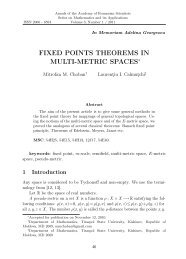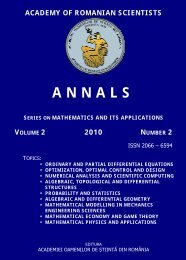convergence of the fractional parts of the random variables to the ...
convergence of the fractional parts of the random variables to the ...
convergence of the fractional parts of the random variables to the ...
You also want an ePaper? Increase the reach of your titles
YUMPU automatically turns print PDFs into web optimized ePapers that Google loves.
Convergence <strong>of</strong> <strong>the</strong> <strong>fractional</strong> <strong>parts</strong> <strong>of</strong> <strong>the</strong> <strong>random</strong> <strong>variables</strong> 119<br />
This <strong>the</strong>ory was analysed by Wilms in [9], where <strong>the</strong> study <strong>of</strong> <strong>convergence</strong><br />
<strong>of</strong> <strong>the</strong> <strong>fractional</strong> <strong>parts</strong> <strong>of</strong> <strong>the</strong> sum <strong>of</strong> <strong>random</strong> <strong>variables</strong> it was directed <strong>to</strong>wards<br />
<strong>the</strong> uniform distribution on <strong>the</strong> interval [0, 1]. Moreover, he identifed <strong>the</strong><br />
necessary and sufficient conditions for <strong>the</strong> <strong>convergence</strong> <strong>of</strong> <strong>the</strong> product <strong>of</strong> <strong>the</strong><br />
<strong>random</strong> <strong>variables</strong>, not necessary independent and identically distributed,<br />
<strong>to</strong>wards <strong>the</strong> same uniform distribution on <strong>the</strong> interval [0, 1]. The Fourier-<br />
Stieltjes sequence, (see Definition 1), play an important role in <strong>the</strong> study <strong>of</strong><br />
<strong>fractional</strong> <strong>parts</strong> <strong>of</strong> <strong>random</strong> <strong>variables</strong>. Also, Wilms obtain conditions under<br />
which <strong>fractional</strong> <strong>parts</strong> <strong>of</strong> products <strong>of</strong> independent and identically distributed<br />
<strong>random</strong> <strong>variables</strong> are uniform distribution on <strong>the</strong> interval [0, 1]. After a<br />
survey <strong>of</strong> some results by Schatte in [6], Wilms extend <strong>the</strong> results <strong>of</strong> Schatte<br />
on sums <strong>of</strong> independent and identically distributed lattice <strong>random</strong> <strong>variables</strong>.<br />
Fur<strong>the</strong>rmore, Schatte in [6], gives rates for <strong>the</strong> <strong>convergence</strong> <strong>of</strong> distribution<br />
function <strong>of</strong> <strong>the</strong> <strong>fractional</strong> <strong>parts</strong> <strong>of</strong> <strong>the</strong> sum <strong>of</strong> <strong>random</strong> <strong>variables</strong> <strong>to</strong> distribution<br />
function <strong>of</strong> <strong>random</strong> <strong>variables</strong> with continouous uniform distribution on <strong>the</strong><br />
interval [0, 1].<br />
The novelty <strong>of</strong> this paper consist in <strong>the</strong> identification <strong>of</strong> <strong>the</strong> conditions<br />
(Theorems 4, 5, 6) when <strong>the</strong> distribution <strong>of</strong> <strong>the</strong> <strong>fractional</strong> <strong>parts</strong> <strong>of</strong> <strong>the</strong> sum<br />
<strong>of</strong> <strong>random</strong> <strong>variables</strong> converge <strong>to</strong> <strong>the</strong> truncated exponential distribution.<br />
2 Notations, definitions and auxiliary results<br />
Let (Ω , F , P) be <strong>the</strong> probability space and a <strong>random</strong> variable X, X : Ω → R<br />
measurable function. The distribution <strong>of</strong> <strong>random</strong> variable X is <strong>the</strong> measure<br />
<strong>of</strong> probability P X defined on B(R) Borel and P X (B) = P (X ∈ B). The<br />
distribution function <strong>of</strong> <strong>the</strong> <strong>random</strong> variable X is F X (x) = P(X < x), x ∈ R,<br />
x∫<br />
or F X (x) = f X (y)dy where f X represents <strong>the</strong> density <strong>of</strong> probability <strong>of</strong><br />
−∞<br />
<strong>the</strong> <strong>random</strong> variable X.<br />
Throughout <strong>the</strong> paper, for A ⊂ R, F(A) = {F X | P (X ∈ A) = 1}.<br />
For <strong>the</strong> <strong>random</strong> variable X, <strong>the</strong> <strong>fractional</strong> part <strong>of</strong> X is defined as follows:<br />
{X} = X − [X], where [X] represents <strong>the</strong> integer part <strong>of</strong> X.<br />
The distribution function <strong>of</strong> <strong>the</strong> <strong>random</strong> variable {X} for any x ∈ [0, 1]<br />
is<br />
F {X} (x) =<br />
∞∑<br />
m=−∞<br />
P(m ≤ X < m + x) =<br />
∞∑<br />
m=−∞<br />
(F X (m + x) − F X (m)) .






